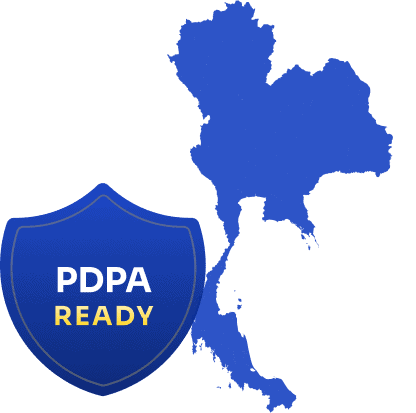The Personal Data Protection Act (PDPA) is a Singaporean law that regulates the collection, use, and disclosure of personal data. Businesses that handle personal data are required to comply with the PDPA or face penalties and fines. In this blog post, we will discuss 10 steps that businesses in Singapore can take to ensure PDPA compliance.

- Appoint a Data Protection Officer (DPO) Under the PDPA, businesses are required to appoint a DPO to oversee data protection matters. The DPO is responsible for ensuring that the business complies with the PDPA, and serves as the point of contact for data protection issues. Businesses should ensure that their DPO is trained and qualified to handle data protection matters.
Under the Personal Data Protection Act (PDPA) in Singapore, businesses are required to appoint a Data Protection Officer (DPO) to oversee data protection matters. The DPO plays a critical role in ensuring that the business complies with the PDPA and protects personal data appropriately.
The primary responsibility of the DPO is to manage the business’s data protection policies and practices. This includes developing and implementing data protection policies and procedures, conducting privacy impact assessments (PIAs), and ensuring that employees are trained on data protection practices.
In addition to managing data protection policies and practices, the DPO also serves as the point of contact for data protection issues. This includes responding to requests from individuals to access or correct their personal data, and reporting data breaches to the Personal Data Protection Commission (PDPC).
To be appointed as a DPO, individuals must meet the following criteria:
- Must be a resident of Singapore
- Must possess knowledge and expertise in data protection
- Must be able to carry out the duties and responsibilities of a DPO effectively
Businesses can appoint an internal staff member as their DPO, or outsource the role to a third-party service provider. Regardless of who is appointed as the DPO, they must be adequately trained and qualified to handle data protection matters.
The role of the DPO is essential for businesses in Singapore that handle personal data. By appointing a DPO and ensuring that they are properly trained and qualified, businesses can ensure that they comply with the PDPA and protect personal data appropriately. Failure to comply with the PDPA can result in significant penalties and fines, as well as reputational damage. Therefore, it is crucial that businesses take the appointment of a DPO seriously and ensure that they are fulfilling their responsibilities effectively.
- Conduct a Data Inventory Businesses should conduct a data inventory to identify all personal data that they collect, use, and disclose. This includes data that is stored electronically or in hard copy form. By conducting a data inventory, businesses can better understand their data handling practices and ensure that they are complying with the PDPA.
Conducting a data inventory is an essential step in ensuring PDPA compliance for businesses in Singapore. A data inventory is the process of identifying and documenting all personal data that a business collects, processes, and stores.
The purpose of a data inventory is to help businesses understand the scope of personal data they handle, the purposes for which they collect and process personal data, and the risks associated with personal data handling. Conducting a data inventory allows businesses to identify areas where they may need to improve their data protection practices and helps them comply with the PDPA.
Here are ten steps that businesses can follow to conduct a data inventory in PDPA compliance in Singapore:
- Identify all departments and business units that handle personal data.
- Identify all types of personal data that the business collects, processes, and stores. This includes both online and offline data.
- Document the purposes for which personal data is collected and processed.
- Identify all third-party service providers that handle personal data on behalf of the business.
- Document the data transfer arrangements that the business has with third-party service providers and any overseas entities.
- Identify any data protection risks associated with personal data handling, such as the risk of unauthorized access, use, or disclosure.
- Document any existing data protection policies and procedures that the business has in place.
- Identify any gaps or weaknesses in the existing data protection policies and procedures.
- Develop and implement additional data protection policies and procedures to address any gaps or weaknesses identified.
- Regularly review and update the data inventory to ensure that it remains accurate and up-to-date.
By following these steps, businesses in Singapore can conduct a comprehensive data inventory to ensure that they comply with the PDPA. This will help them identify areas where they need to improve their data protection practices and ensure that they are protecting personal data appropriately. It is crucial for businesses to take data protection seriously to avoid significant penalties and fines, as well as reputational damage that may arise from non-compliance.
- Implement Data Protection Policies and Procedures Businesses should develop and implement data protection policies and procedures to ensure that personal data is handled appropriately. These policies should address issues such as data retention, data security, and data disclosure. By implementing these policies and procedures, businesses can ensure that their employees are aware of their data protection obligations.
Data protection policies and procedures are essential for any organization that collects, uses, or discloses personal data. In Singapore, organizations are required to comply with the Personal Data Protection Act (PDPA) when handling personal data. Here are the steps to implement data protection policies and procedures in PDPA compliance:
- Develop a Data Protection Policy: The first step is to develop a comprehensive data protection policy that outlines your organization’s commitment to protecting personal data. The policy should cover how personal data is collected, used, disclosed, stored, and secured. It should also outline the roles and responsibilities of employees and management in safeguarding personal data.
- Conduct a Data Protection Impact Assessment: A Data Protection Impact Assessment (DPIA) is a process that identifies and assesses the risks and potential harms associated with the processing of personal data. Conducting a DPIA is mandatory for certain types of data processing activities under the PDPA. It is recommended that organizations conduct DPIAs for all high-risk data processing activities.
- Implement Appropriate Technical and Organizational Measures: Organizations should implement appropriate technical and organizational measures to protect personal data. Technical measures may include encryption, access controls, and firewalls. Organizational measures may include training employees on data protection policies and procedures, conducting regular data protection audits, and maintaining records of data processing activities.
- Obtain Consent: Organizations must obtain consent from individuals before collecting, using, or disclosing their personal data. The consent must be informed, specific, and given voluntarily. Organizations should also provide individuals with a clear and easy-to-understand privacy notice that outlines the purposes for which their data is being collected, used, or disclosed.
- Respond to Data Subject Requests: Individuals have the right to access, correct, and delete their personal data under the PDPA. Organizations must establish procedures for responding to data subject requests in a timely and effective manner.
- Monitor and Review: Finally, organizations should establish a monitoring and review process to ensure that their data protection policies and procedures are being followed. Regular reviews should be conducted to identify areas for improvement and ensure that the policies and procedures remain up-to-date with changes in the law and organizational practices.
By following these steps, organizations can establish robust data protection policies and procedures that comply with the PDPA and protect the personal data of individuals.

- Conduct Privacy Impact Assessments (PIAs) PIAs are assessments that businesses can conduct to identify and mitigate privacy risks associated with their data handling practices. Businesses should conduct PIAs for new projects or initiatives that involve the collection, use, or disclosure of personal data. By conducting PIAs, businesses can identify and address privacy risks before they become a problem.
A Privacy Impact Assessment (PIA) is a process used to identify, assess, and mitigate privacy risks associated with the collection, use, or disclosure of personal data. In Singapore, under the Personal Data Protection Act (PDPA), organizations are required to conduct a PIA when introducing a new product or service that involves the processing of personal data or when making significant changes to an existing product or service that involves personal data. Here are the steps to conduct a PIA in PDPA compliance Singapore:
- Identify the need for a PIA: The first step is to determine whether a PIA is necessary. This can be done by reviewing the nature and scope of the proposed product or service and assessing the level of risk associated with the processing of personal data.
- Establish a PIA team: The next step is to establish a PIA team. This team should include individuals with expertise in privacy, data protection, and information security.
- Define the scope of the PIA: The scope of the PIA should be clearly defined. This includes identifying the personal data that will be collected, used, or disclosed, the purposes for which the data will be processed, and the parties involved in the processing of the data.
- Conduct a privacy risk assessment: The privacy risk assessment is the heart of the PIA process. This involves identifying potential privacy risks associated with the processing of personal data and assessing the likelihood and impact of those risks.
- Develop mitigation strategies: Based on the results of the privacy risk assessment, the PIA team should develop mitigation strategies to address the identified risks. This may include implementing technical or organizational measures to minimize the risks or revising the proposed product or service to reduce the privacy risks.
- Document the PIA: The PIA process and its findings should be documented, including the privacy risk assessment, mitigation strategies, and any changes made to the proposed product or service.
- Review and update the PIA: The PIA should be reviewed and updated periodically to ensure that it remains current and relevant. This should include reviewing the effectiveness of the mitigation strategies and assessing whether any changes to the product or service have resulted in new privacy risks.
By following these steps, organizations can conduct a thorough and effective PIA in compliance with the PDPA. The PIA process can help organizations to identify and mitigate privacy risks associated with the processing of personal data and ensure that they are compliant with the PDPA.
- Obtain Consent for Data Collection, Use, and Disclosure Under the PDPA, businesses are required to obtain consent from individuals before collecting, using, or disclosing their personal data. Businesses should ensure that they obtain explicit and informed consent from individuals, and provide them with information about the purpose of data collection, use, and disclosure.
Under the Personal Data Protection Act (PDPA) in Singapore, organizations are required to obtain consent from individuals before collecting, using, or disclosing their personal data. Here are the key considerations for obtaining consent for data collection, use, and disclosure in PDPA compliance:
- Consent must be informed: Organizations must provide individuals with clear and comprehensive information about the purposes for which their personal data will be collected, used, or disclosed. This includes identifying the types of personal data that will be collected, who the data will be shared with, and the purposes for which the data will be used.
- Consent must be specific: Consent must be obtained for specific purposes and must not be obtained for any other purposes without obtaining additional consent.
- Consent must be voluntary: Consent must be given freely and voluntarily without coercion or undue influence. Organizations must not make consent a condition for providing a product or service, unless the collection, use or disclosure of the personal data is necessary to provide that product or service.
- Consent must be documented: Organizations must maintain a record of when and how consent was obtained, including the information provided to individuals about the purposes for which their personal data will be collected, used, or disclosed.
- Withdrawal of consent: Individuals have the right to withdraw their consent at any time. Organizations must provide a simple and free-of-charge process for individuals to withdraw their consent.
- Children’s consent: If the individual is a child under the age of 13, organizations must obtain consent from their parent or legal guardian.
- Overseas data transfer: If personal data is transferred outside of Singapore, organizations must obtain consent from the individual and take reasonable steps to ensure that the overseas recipient provides a comparable level of protection for the personal data.
By following these key considerations, organizations can obtain valid consent for the collection, use, and disclosure of personal data in compliance with the PDPA. Obtaining valid consent is an important step in protecting the privacy of individuals and ensuring that organizations are compliant with the PDPA.

- Implement Data Security Measures Businesses should implement data security measures to protect personal data from unauthorized access, use, or disclosure. This includes measures such as encryption, firewalls, and access controls. By implementing these measures, businesses can minimize the risk of data breaches and ensure that personal data is protected.
Under the Personal Data Protection Act (PDPA) in Singapore, organizations are required to implement reasonable security measures to protect personal data from unauthorized access, collection, use, disclosure, copying, modification, disposal or similar risks. Here are some key steps to implement data security measures in PDPA compliance:
- Conduct a risk assessment: Organizations should conduct a risk assessment to identify the types of personal data they collect, the security threats and vulnerabilities they face, and the potential impact of a data breach. The risk assessment should consider factors such as the sensitivity of the data, the potential harm to individuals if the data is compromised, and the likelihood of a data breach occurring.
- Develop a data protection policy: Organizations should develop a data protection policy that outlines their approach to data security, including the measures they will implement to protect personal data. The policy should be reviewed and updated periodically to ensure that it remains effective.
- Implement access controls: Access controls should be implemented to ensure that only authorized individuals have access to personal data. This may include password policies, two-factor authentication, and restricted physical access to data storage areas.
- Use encryption and pseudonymization: Organizations should use encryption and pseudonymization to protect personal data from unauthorized access. Encryption can be used to protect data in transit and data at rest, while pseudonymization can be used to replace identifying information with a pseudonym.
- Implement data retention and disposal policies: Organizations should implement data retention and disposal policies to ensure that personal data is not kept longer than necessary. The policies should include procedures for securely disposing of personal data when it is no longer needed.
- Train employees: Employees should be trained on the organization’s data protection policies and procedures, including how to handle personal data securely. This should include regular training and awareness programs to ensure that employees are aware of their obligations and the importance of data protection.
- Regularly review and update security measures: Organizations should regularly review and update their security measures to ensure that they remain effective. This may include conducting regular security audits, vulnerability scans, and penetration testing.
By implementing these data security measures, organizations can protect personal data from unauthorized access, use, and disclosure in compliance with the PDPA. Effective data security measures can help organizations to reduce the risk of data breaches and ensure that they are compliant with their obligations under the PDPA.
- Train Employees on Data Protection Practices Employees play a critical role in ensuring PDPA compliance. Businesses should provide training to employees on data protection practices, including how to handle personal data appropriately and how to identify and report data breaches.
Training employees on data protection practices is essential for ensuring compliance with the Personal Data Protection Act (PDPA) in Singapore. Here are some key steps that organizations can take to train employees on data protection practices:
- Develop a data protection policy: Develop a comprehensive data protection policy that outlines the organization’s approach to data protection, including the measures they will implement to protect personal data. The policy should be reviewed and updated regularly to ensure that it remains effective.
- Communicate the policy: Communicate the data protection policy to all employees and stakeholders, and ensure that they understand their roles and responsibilities in protecting personal data.
- Conduct regular training sessions: Conduct regular training sessions on data protection practices for all employees. The training should cover the principles of the PDPA, the organization’s data protection policy, and the procedures that employees should follow to protect personal data.
- Use real-life scenarios: Use real-life scenarios and examples to illustrate the importance of data protection and the potential consequences of data breaches. This will help employees to understand the impact of their actions on personal data protection.
- Provide refresher training: Provide refresher training to employees on a regular basis to ensure that they are aware of any updates to the organization’s data protection policy and any new developments in data protection practices.
- Establish reporting procedures: Establish clear reporting procedures for employees to report any data breaches or incidents to their managers or data protection officers. This will help to ensure that data breaches are identified and addressed promptly.
- Foster a culture of data protection: Foster a culture of data protection within the organization by promoting the importance of data protection and encouraging employees to take ownership of their role in protecting personal data.
By training employees on data protection practices, organizations can ensure that personal data is protected in compliance with the PDPA. Effective training can help employees to understand their responsibilities, reduce the risk of data breaches, and contribute to a culture of data protection within the organization.

- Conduct Regular Audits and Reviews Businesses should conduct regular audits and reviews of their data protection practices to ensure that they are complying with the PDPA. These audits and reviews can identify areas for improvement and ensure that the business remains compliant with the PDPA.
Conducting regular audits and reviews is an important part of maintaining compliance with the Personal Data Protection Act (PDPA) in Singapore. Here are some key steps that organizations can take to conduct regular audits and reviews:
- Establish a data protection audit schedule: Establish a regular data protection audit schedule that outlines the frequency and scope of audits. The audit schedule should be reviewed and updated periodically to ensure that it remains relevant.
- Conduct internal audits: Conduct regular internal audits to assess compliance with the organization’s data protection policy and procedures. This may include reviewing data protection policies and procedures, assessing access controls, reviewing data retention and disposal policies, and identifying any areas of non-compliance.
- Conduct external audits: Consider engaging external auditors to conduct an independent assessment of the organization’s compliance with the PDPA. This can help to identify any areas of non-compliance and provide recommendations for improvement.
- Review data protection policies and procedures: Regularly review data protection policies and procedures to ensure that they remain effective and are aligned with best practices and regulatory requirements.
- Assess the effectiveness of data security measures: Regularly assess the effectiveness of data security measures, such as access controls, encryption, and pseudonymization, to ensure that they are effective in protecting personal data.
- Review data breach response plans: Regularly review data breach response plans to ensure that they are up-to-date and effective in responding to data breaches.
- Address areas of non-compliance: Address any areas of non-compliance identified through audits and reviews promptly. This may involve updating policies and procedures, implementing additional data security measures, or providing additional training to employees.
By conducting regular audits and reviews, organizations can identify areas of non-compliance and take corrective action to ensure that personal data is protected in compliance with the PDPA. Regular audits and reviews can also help to identify opportunities for improvement and ensure that data protection policies and procedures remain effective in a rapidly changing regulatory environment.
- Respond to Data Breaches Appropriately Under the PDPA, businesses are required to report data breaches to the Personal Data Protection Commission (PDPC) and affected individuals. Businesses should have a data breach response plan in place to ensure that they can respond quickly and appropriately to data breaches.
Responding to data breaches appropriately is critical for maintaining compliance with the Personal Data Protection Act (PDPA) in Singapore. Here are some key steps that organizations can take to respond to data breaches appropriately:
- Contain the breach: As soon as a data breach is identified, the organization should take immediate steps to contain the breach and prevent further unauthorized access to personal data. This may involve disabling accounts, changing passwords, or taking other measures to limit access to personal data.
- Assess the impact: The organization should assess the impact of the breach, including the nature and extent of the personal data involved, the number of individuals affected, and the potential harm to individuals.
- Notify affected individuals: The organization should notify affected individuals as soon as possible, providing them with information about the breach, the personal data involved, and the steps that they can take to protect themselves from harm.
- Notify the Personal Data Protection Commission (PDPC): If the breach involves the personal data of more than 500 individuals, or if the organization is uncertain about whether to notify the PDPC, they should notify the PDPC as soon as possible.
- Review and update data protection policies and procedures: The organization should review and update data protection policies and procedures in light of the breach, taking into account any lessons learned or areas for improvement.
- Conduct a post-incident review: The organization should conduct a post-incident review to identify the cause of the breach, assess the effectiveness of the organization’s response, and identify any areas for improvement.
- Provide support to affected individuals: The organization should provide support to affected individuals, such as offering credit monitoring services, counseling services, or other forms of support as appropriate.
By responding to data breaches appropriately, organizations can minimize harm to affected individuals, maintain compliance with the PDPA, and build trust with their customers and stakeholders. It is essential to have a clear and effective data breach response plan in place to ensure that the organization can respond quickly and effectively to any data breaches that may occur.

- Monitor PDPC Updates and Changes The PDPC regularly updates its guidelines and regulations related to the PDPA. Businesses should monitor these updates and changes to ensure that they are complying with the latest requirements. Businesses should also seek legal advice if they are unsure about their PDPA obligations.
Monitoring updates and changes to the Personal Data Protection Commission’s (PDPC) guidance and regulations is essential for maintaining compliance with the Personal Data Protection Act (PDPA) in Singapore. Here are some key steps that organizations can take to monitor PDPC updates and changes:
- Subscribe to PDPC alerts: Subscribe to PDPC alerts, such as the PDPC e-Alert, to receive updates on the latest PDPC guidance and regulations.
- Monitor PDPC website: Monitor the PDPC website regularly for updates to guidance, regulations, and other resources related to the PDPA.
- Attend PDPC events: Attend PDPC events, such as seminars, webinars, and workshops, to stay up-to-date on the latest developments in PDPA compliance.
- Engage with industry associations: Engage with industry associations, such as the Association of Information Security Professionals (AISP) or the Singapore Computer Society (SCS), to stay informed about the latest developments in PDPA compliance.
- Consult with legal counsel: Consult with legal counsel to stay informed about the latest legal developments and to ensure that the organization’s policies and procedures are aligned with the latest guidance and regulations.
- Review and update policies and procedures: Review and update data protection policies and procedures regularly to ensure that they remain aligned with the latest PDPC guidance and regulations.
By monitoring updates and changes to PDPC guidance and regulations, organizations can ensure that they remain compliant with the PDPA and avoid any potential penalties or reputational harm. Staying up-to-date on the latest developments in PDPA compliance can also help organizations to identify opportunities for improvement and to maintain a strong culture of data protection within the organization.
In conclusion, PDPA compliance is essential for businesses in Singapore that handle personal data. By following these 10 steps, businesses can ensure that they are complying with the PDPA and protecting personal data appropriately. Failure to comply with the PDPA can result in significant penalties and fines, as well as reputational damage.
Check this out:
https://www.i2coms.com/pdpa-compliance-singapore/
https://www.i2coms.com/

